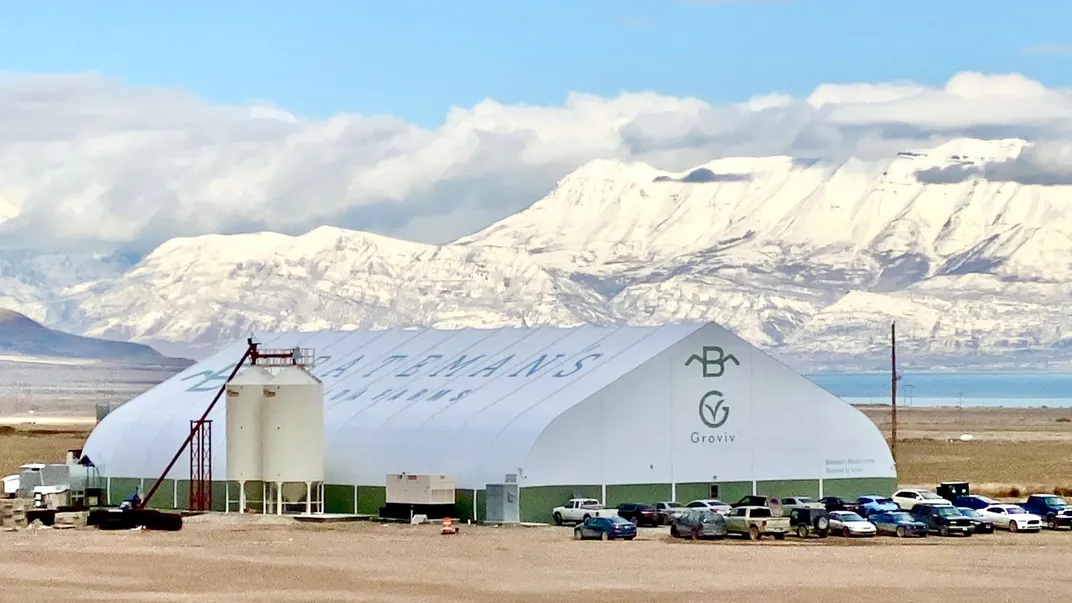Could Indoor Vertical Farms Feed Livestock?
The people at Grōv Technologies think farmers can produce wheatgrass for their herds with less land and water using the method
/https://tf-cmsv2-smithsonianmag-media.s3.amazonaws.com/filer/df/28/df28f88c-e320-48b3-8ddd-69cf862299d2/vertical_farming.jpg)
Along Utah’s Highway 68 in the small community of Elberta, Utah stands an industrial dome. Inside is a futuristic collection of stacked shelves, towering 25 feet tall, that systematically flicker with pink lights.
The dome is home to a vertical farm, but it’s not your typical lettuce-growing operation you’d find in the warehouses of densely populated cities. This vertical farm doesn’t grow food for humans but for cows.
Three years ago, Lance Bateman and his three brothers agreed to be part of a pilot project that would use vertical farming to grow and feed the cows for their dairy and beef ranch, Bateman Mosida Farms. Grōv Technologies, an agriculture tech company in Vineyard, Utah, partnered with the Batemans on the project and developed all the equipment for the vertical farm.
The brothers are now using six towers to pump out fresh wheatgrass for their herd of 20,000 cows 365 days a year.
“Is it going to be the cheapest feed? Probably not,” says Bateman. “But is it going to be the most consistent and desirable feed for the animals? I think so.”
The vertical farm takes up about 857 square feet of space, but it does the work that would be required on 35 to 50 acres of land, according to Grōv Technologies. Proponents claim vertical farms use 95 percent less water than in conventional field farming. A full harvest cycle in the Batemans’ farm takes anywhere from five to seven days, starting with a tray of seeds that is carried to the top of the tower and rotated on wheels through the entire structure.
Each tray is watered automatically and treated with low-heat LED grow lights before the final product rolls out of the bottom shelf on a conveyor belt.
Bateman says each tower provides about 2,800 pounds of feed each day, which is only about two percent of what his cows eat in a day. His farm grows feed conventionally when it can and buys the rest. The farm is also planning to install four more towers within the next six weeks.

Grōv Technologies is one of a handful of companies around the world that is helping farmers set up their own vertical farms to grow feed for their livestock year round. Steve Lindsley, the president of Grōv Technologies, says he believes using vertical farms to grow feed could become more widespread in the future.
“[If] we’re going to feed 2.5 billion more people in the next 30 years than we have today, and we have to do it with arguably less land and less water because of climate change, this technology is profoundly important,” he says.
According to the United Nations Food and Agriculture Organization, one third of the planet’s land is currently used for livestock feed production. And as the world’s population grows, so does the demand for animal protein. Meanwhile, studies have shown that five million hectares of forested land globally are being converted into space for agriculture each year.
In addition to the environmental benefits of using vertical farming to grow livestock feed, Bateman says the project has had financial benefits, too, for the farm. According to Bateman, a few preliminary studies that have been conducted with Grōv Technologies in 2019 found that, when the cows were fed just 12-15 percent of the vertical farm’s feed in their diets, they produced more milk or at the same pace while eating less feed overall, ultimately improving the farm’s bottom line.
“A farm is an expensive venture, yet I know with this facility, we can compete, especially with different climate scenarios across the country and the world,” he says. “I believe this is going to make farming available in areas where it hasn’t been able to happen.”
The farm is still in the early stages of determining how to maximize the effectiveness of vertical farming for feeding its cattle. But Bateman hopes the operation will help ensure his family’s farm is in fine form once it’s time to pass it down to the next generation.